During the course of our '40 Days to 40 Years' blogging, we will give you different options for exploring the John D. Rockefeller, Jr. Memorial Parkway. This past Tuesday, I chose a more unusual one; rather than pulling out my hiking boots and setting out on one of the trails, my parents and I rented kayaks and floated down the Snake River from Flagg Ranch to Lizard Creek.
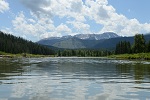 The northern Teton range and the Snake River
The northern Teton range and the Snake River
The trip requires some sort of shuttle, so our group left a car in Lizard Creek Campground and drove another with the kayaks up to the Snake River bridge parking area by Flagg Ranch. The trip down this section of the Snake River is not a difficult one, but it is not a section for beginners either, as it requires navigating around gravel bars and downed trees.
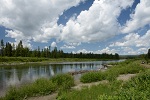 Launch at the Snake River bridge
Launch at the Snake River bridge
The six-mile stretch from Flagg Ranch to the north end of Jackson Lake begins with landscapes associated with Yellowstone National Park. Cliffs made from ancient lava flows from the Yellowstone volcano line the river, while hillsides are covered with young lodgepole pine trees slowly growing back after fires in 1988 burned through an older forest.
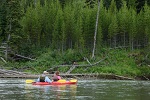 Kayakers float by young lodgepole pine trees.
Kayakers float by young lodgepole pine trees.
One person in our group brought his fly-fishing pole with him, but the water was too full of sediment for fishing to be successful. Instead, we kept an eye out for different species of birds found in riparian habitats. A pair of cormorants watched as we floated by, while the mergansers took off at the first sight of our boats.
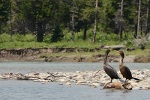 Double-crested Cormorants
Double-crested Cormorants
Further down the river, the northern end of the Teton Range looms larger and larger in the background. As the river transitions into the northern end of Jackson Lake, the current starts to disappear and the land next to the becomes more marsh-like. The soundscape changes as well - rather than the high-pitched call of sandpipers, the squawking of Canada geese is the dominant birdcall. To our great excitement, a flash of white in the distance turned out to be a rare trumpeter swan, rather than the more commonly seen American white pelican.
 Trumpeter Swan and Canada Geese
Trumpeter Swan and Canada Geese
Eventually, the open waters of Jackson Lake spread out before us. Lewis and Clark may have had a similar experience upon reaching the Pacific Ocean - the Snake River, after all, is a tributary of the Columbia River that they were traveling upon. However, I imagine their ocean sighting generated more excitement - for them it meant their westward journey was finished, while for us it meant we had four more miles of paddling until we reached Lizard Creek Campground and our vehicle!
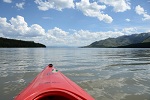 The open waters of Jackson Lake
The open waters of Jackson Lake
Luckily, Jackson Lake was not as choppy as usual, and the increasingly-better views of Owl and Webb Canyon across the lake provided a distraction. Two hours later we paddled up to the beach at the campground, happy to load our kayaks back onto the car and head home for a rest and some well-deserved dinner.
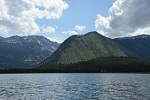 Webb and Owl Canyons
Webb and Owl Canyons
Until next time, Bon Voyage!
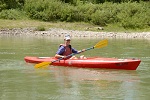 -DL
-DL
